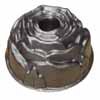




Last summer an old friend who has been trying to find himself for 50-odd years decided to move the search overseas. At his leaving-the-country yard sale I picked up a top-of-the-line, unused, Nordic Ware non-stick Bundt pan, which I've been promising myself I would use.
This week's vacation, plus a potluck invitation for this evening, seemed like a good oppportunity.
What is a "Bundt?"
Bundt is what happened when a traditional Eastern European Kugelhopf pan (used to bake yeasted cakes) met a marketing department.
A Kugelhopf pan is a circular metal mold, sometimes with peaks. The ladies of Minneapolis Hadassah approached Nordic Ware with a request for a Kugelhopf pan, Nordic Ware designers came up with one, and the cookware company went on to promote it as a "Bundt pan" for the baking of regular (non-yeasted) cakes. In the 1960s, Bundt cakes made it into the mainstream via cooking contests and ladies magazines and in 1972 Pillbury began to sell special Bundt cake mixes for the 12-cup batter pans. Nordic Ware now makes Bundt pans in dozens of shapes and sizes: Star, Cathedral, Chrysanthemum, Holiday Tree, Fleur-de-Lis, Bavaria, Rose -- even a Bundt brownie pan. But the ultimate, the absolute ultimate, is Williams-Sonoma's Bundt Sandcastle pan (apparently a W-S exclusive), which inspired this blog entry from High Maintenance Mom. According to the Nordic Ware site, there are now 45 million Bundt pans in American homes. Since moving to Ballard, I have met quite a few nice Bundt pans at yard sales.
BTW, mine's a plain Bundt pan.
The retro charm of the Bundt pan, especially a non-stick one like the high-end Nordic Ware, is that you can create an extremely fancy-looking cake without much work. These things don't even have frosting, just a sprinkling of powdered sugar that goes on after the cake has cooled. Theoretically, you could get away with just mixing up a cake mix (make sure it's for a 12-cup Bundt pan), dumping it in, and baking it.
Tips and tricks
But of course, there are some tricks. Such as getting such an elaborately crenellated cake out of the pan in one piece. Cook's Illustrated described one tip that involved lining the sink with towels, pouring on boiling water, and setting the "top" of the pan down on the towels for 10 seconds before turning it over to deposit the cake onto the parchment-covered cooling rack. Another Cook's Illustrated recipe has you prep the pan beforehand, thoroughly greasing all the interior ridges by brushing them with a mixture that's equal parts butter and cocoa powder, combined and heated (microwaved) to just-melting.
After contemplating a shelf of sticky-looking cake mixes at the local grocery, I went home and put together a chocolate sour cream Bundt cake recipe from Cook's Illustrated, including the greasing of the interior of the pan. My one frustration was that cookbooks seem to assume that everyone has a deep-bowl, KitchenAid standing mixer. Using a hand mixer works, but increases the probability that you'll splatter batter all over the kitchen as you stop to use a splatula between each step of the mixing. (Note to self: Get the batter off the refrigerator door.)
The cake is now out of the pan, cooling, and I'll post a picture after I apply the powdered sugar. Now, if only I had the Deluxe Bundt Cake Keeper. Ya, sure, you betcha!
I'm making a bundt cake right now and those suggestions on getting the cake out of the pan really help, thanks!
ReplyDeleteI have a chilton pan and it is wonderful. Years ago I used crisco but stopped that when I found out how wonderful and light spray of Pam worked. I have never had a problem. The great thing about the chilton pan is it is heavy. I wish I could buy them now but cannot located them at this time,
ReplyDelete